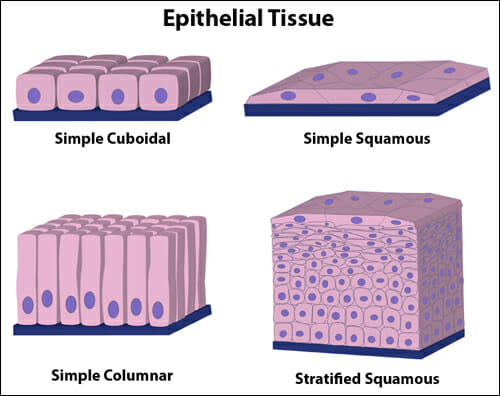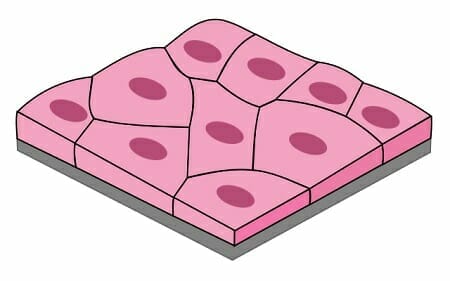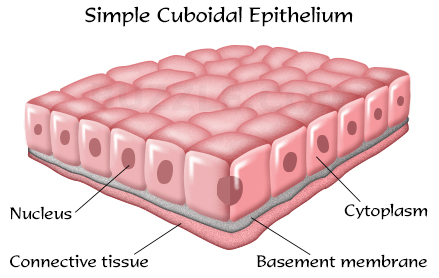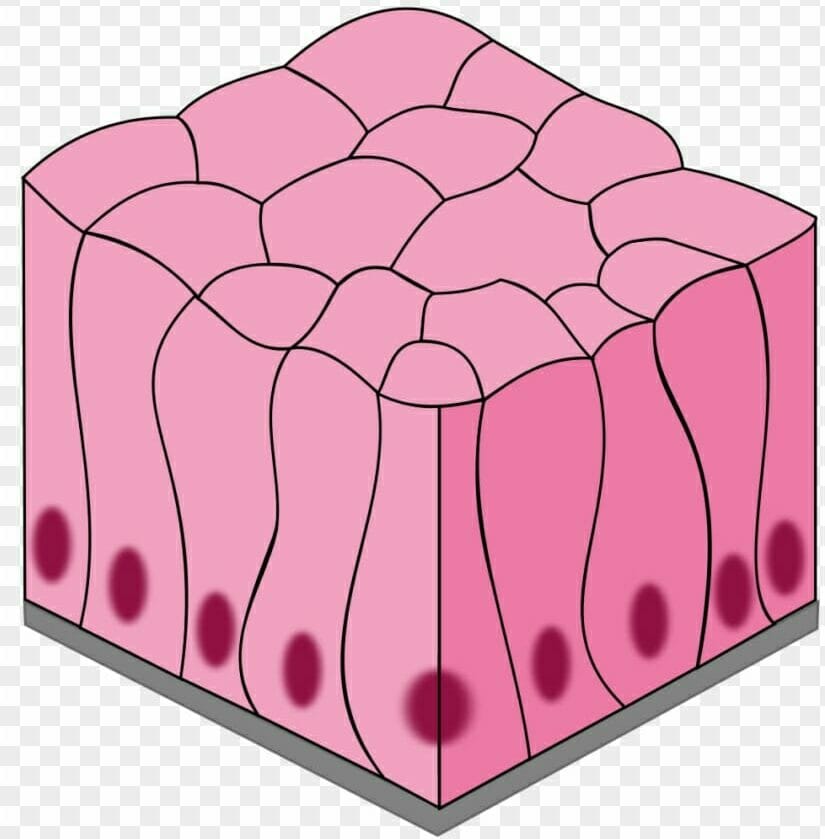Table of Contents
Epithelial Tissues – Types
Epithelial Tissue
This tissue type covers the body and lines cavities, hollow organs, and tubes. It is also found in glands. The cells are very closely packed and the intercellular substance, the matrix, is minimal. The cells usually lie on a basement membrane, which is an inert connective tissue made by the epithelial cells themselves.

Epithelial tissue may be:
• Simple epithelium: a single layer of cells
• Stratified epithelium: several layers of cells.
- Simple Epithelium
- Squamous Cell Epithelium
- Cuboidal Epithelium
- Columnar Epithelium
2. Stratified Epithelium
a. Stratified Squamous Epithelium
- i. Non-keratinized stratified epithelium
- ii. Keratinized stratified epithelium
b. Transitional Epithelium
The structure of epithelium is closely related to its functions, which include:
• Protection of underlying structures from dehydration, chemical and mechanical damage
• Secretion
• Absorption.
Simple epithelium
The simple epithelium consists of a single layer of identical cells and is divided into three main types.
It is usually found on absorptive or secretory surfaces, where the single layer enhances these processes, and seldom on surfaces subject to stress.
The types are named according to the shape of the cells, which differ according to their functions. The more active the tissue, the taller the cells.
Types of Simple Epithelium
- Squamous Epithelium
- Cuboidal Epithelium
- Columnar Epithelium
Squamous (pavement) epithelium
This is composed of a single layer of flattened cells. The cells fit closely together like flat stones, forming a thin and very smooth membrane across which diffusion occurs easily.

It forms the lining of the following structures:
- heart – where it is known as Endocardium
- blood vessels and lymph vessels – where it is known as the endothelium
- Alveoli of the lungs
- lining the collecting ducts of nephrons in the kidneys
Cuboidal Epithelium
This consists of cube-shaped cells fitting closely together lying on a basement membrane. It forms the kidney tubules and is found in some glands such as the thyroid. Cuboidal epithelium is actively involved in secretion, absorption and/or excretion.

Columnar epithelium
This is formed by a single layer of cells, rectangular in shape, on a basement membrane. It lines many organs and often has adaptations that make it well suited to a specific function.

The lining of the stomach is formed from simple columnar epithelium without surface structures. The free surface of the columnar epithelium lining the small intestine is covered with microvilli. Microvilli provide a very large surface area for the absorption of nutrients from the small intestine.
In the trachea, columnar epithelium is ciliated and also contains goblet cells that secrete mucus.
This means that inhaled particles that stick to the mucus layer are moved towards the throat by cilia in the respiratory tract.
In the uterine tubes, ova are propelled along by ciliary action towards the uterus.
Stratified epithelia
Stratified epithelia consist of several layers of cells of various shapes. Continual cell division in the lower (basal) layers pushes cells above nearer and nearer to the surface, where they are shed. Basement membranes are usually absent. The main function of stratified epithelium is to protect underlying structures from mechanical wear and tear.
There are two main types:
- Stratified squamous Epithelium
- Transitional Epithelium
Stratified squamous epithelium
This is composed of several layers of cells. In the deepest layers the cells are mainly columnar and, as they grow towards the surface, they become flattened and are then shed.
They are two types
Keratinized stratified epithelium and non-keratinized stratified epithelium
Keratinised stratified epithelium
This is found on dry surfaces subjected to wear and tear, i.e. skin, hair and nails. The surface layer consists of dead epithelial cells that have lost their nuclei and contain the protein keratin.
This forms a tough, relatively waterproof protective layer that prevents drying of the live cells underneath. The surface layer of skin is rubbed off and is replaced from below
Non-keratinised stratified epithelium
This protects moist surfaces subjected to wear and tear, and prevents them from drying out, e.g. the conjunctiva of the eyes, the lining of the mouth, the pharynx, the oesophagus and the vagina
Transitional epithelium
This is composed of several layers of pear-shaped cells. It lines several parts of the urinary tract including the bladder and allows for stretching as the bladder fills.
Nursing Exams Important Points to Remember
Please Subscribe Our YouTube channel – The Nurse
Like our Facebook Page: The Nurse
Please Subscribe to get all our posts in your mail inbox